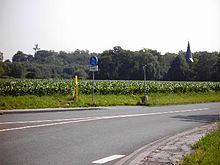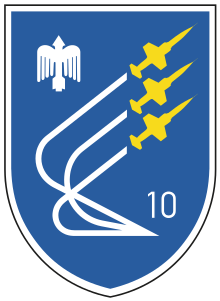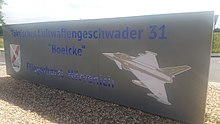Nörvenich Air Base
| Nörvenich Air Base | ||
|---|---|---|
|
|
||
| Characteristics | ||
| ICAO code | ETNN | |
| Coordinates | ||
| Height above MSL | 118 m (387 ft ) | |
| Transport links | ||
| Distance from the city center | 3 km northeast of Nörvenich | |
| Street | Bundesstrasse 477 | |
| train | no | |
| Local transport | none | |
| Basic data | ||
| opening | 1954 | |
| operator | air force | |
| Employees | 450 civilians, 1,850 soldiers | |
| Start-and runway | ||
| 07/25 | 2439 m × 45 m asphalt | |
The Nörvenich Air Base is a military airfield near Nörvenich in the Düren district in North Rhine-Westphalia . It was initially planned for use by the British Royal Air Force (RAF Nörvenich) as another so-called clutch station next to RAF Geilenkirchen , RAF Wildenrath , RAF Brüggen and RAF Laarbruch . This was the name given to newly built RAF bases in the 1950s that were located near the border with the Netherlands and thus as far away as possible from the then inner-German border .
history
With the beginning of the Cold War it was clear that the British Air Force of Occupation, stationed in the British occupation zone from 1945 , would remain in the territory of the Federal Republic of Germany for a longer period of time. The RAF was based in the first years after the war, mainly on former air bases of the former Air Force , some of which are only a few minutes flying time from the "Iron Curtain" in the middle of Europe were removed.
Then it was decided to station the aircraft as far away as possible from the inner-German border . At the beginning of 1952 it became known that an airfield for the RAF was to be built in the Nörvenich Forest. Citizens from the surrounding places in the then Bergheim (Erft) , Düren and Euskirchen districts then formed a home committee that vehemently opposed the airfield. Nevertheless, the North Rhine-Westphalian state government offered the land for sale to the federal government on June 11, 1952. On September 2, 1952, a 50-man survey team began surveying. After minor preparatory work, the construction of the air base officially began on June 15, 1953. On July 1, 1953, around 700 people with black flags marched through Bonn and protested against the building. Nevertheless, on July 15, 1953, a total of 70 Bavarian loggers began clearing the land .
In August 1954, the first British jet aircraft landed in Nörvenich. In December 1955, RAF Germany handed over the airfield to the Federal Minister of Defense . On December 8, 1955, an administrative office for the 1st Air Force Training Company of the recently founded Bundeswehr was set up on the site of the air base . This date is considered to be the hour of birth of the German Air Force . A few days later, the first 13 Bundeswehr soldiers arrived in Nörvenich. After Bundeswehr soldiers were sworn in for the first time on November 12, 1955 in the Krahnenberg barracks in Andernach , the second event of this kind took place in Nörvenich with Federal Defense Minister Theodor Blank on January 2, 1956.
On January 13, 1958 at 3:50 p.m., the first German plane landed at Nörvenich Air Base with Commander Major Gerhard Barkhorn .
On 20 June 1958, the Defense Minister presented Franz Josef Strauss , the Fighter Bomber Wing 31 (FBW 31) with 50 F-84F Thunderstreak the United States Air Force officially commissioned. The JaboG 31 was given the traditional name “ Boelcke ” in April 1961 from Josef Kammhuber , who was then General Inspector of the Air Force . As was customary at that time, some of the soldiers and the squadron management were housed next to the actual airfield a few kilometers away for safety reasons, in the case of Nörvenich this was in the Boelcke barracks in Kerpen, built in 1960. As a result of the 2015 Bundeswehr reform, it will be abandoned in the next few years; the squadron command has been set up on the airfield itself since 2013.
Since January 1959, the squadron was the first unit of the Air Force to report to NATO .
In the fall of 1961, Nörvenich was the first air base of the Air Force on which the Lockheed F-104 G "Starfighter" was stationed. On June 19, 1962, four Lockheed F-104 jet trainers had an accident east of Nörvenich Air Base. The last aircraft of this type left the air base on April 30, 1983.
In the last decade of the Cold War, Nörvenich was also a permanent Forward Operating Location (FOL) of nominally eight A-10 ground attack aircraft of the United States Army Air Forces , which were replaced approximately every two weeks. They formed Detachment 4 (Det. 4) of the 81st Tactical Fighter Wings (81st TFW) based on the English double base RAF Bentwaters / RAF Woodbridge . Det. 3 was activated on October 1, 1979 and decommissioned on March 19, 1992. The rotations, each a third of a squadron, provided the 78th Tactical Fighter Squadron (78th TFS) from Woodbridge until the end of 1988 and the 510th TFS from Bentwaters from the beginning of 1989 .
The first "Tornado" ( Panavia PA 200 ) of the JaboG 31 started in July 1983. In the following almost three decades, around 112,000 flights with around 176,000 flight hours were carried out with the tornado; Pilots have been to Canada for low-level flight training at CFB Goose Bay 21 times . The tornado was officially retired on June 25, 2010. Until then, six pilots had died in accidents with this type. The last tornado with the “Boelcke coat of arms” started on July 15, 2010 from Nörvenich towards Büchel Air Base in the Eifel. Around 150 million euros have already been invested in Nörvenich as part of the switch to the Eurofighter . In the fully functional Eurofighter simulator, Tornado pilots prepare for their retraining for the new weapon system.
At Nörvenich Air Base, there were temporarily US nuclear weapons and the associated delivery systems, e.g. in an inner restricted area that could only be entered by US soldiers . B. Pershing missiles stored. 20 nuclear weapons were relocated to Ramstein Air Base in 1995 . The inner restricted area with high watchtowers can still be seen from outside today.
Air Force weapons school 10
The Luftwaffe 10 weapons school was set up on April 1, 1957 in Nörvenich with a Canadian F-86 Saber Mk. 5 . Initially supported by flight instructors from the Royal Canadian Air Force from Zweibrücken , their job was to train future fighter pilots on the mission model and to create a staff for the new air force fighter squadrons . In September of the same year the association relocated to Oldenburg and began flight operations there in November 1957.
With the beginning of the introduction of the Lockheed F-104 "Starfighter" in January 1960 a training squadron F-104 was set up as the 4th squadron of the weapons school 10 in Nörvenich. The training of the future pilots of the Fighter Bomber Wing 31 took place from April 1961 on the two-seater F-104F. In June 1962, four F-104s of the 4th Squadron crashed during a training flight which was supposed to prepare an aerobatic demonstration in the immediate vicinity of the airfield on the occasion of the commissioning of the F104 units. Since then, any aerobatic demonstration in the Air Force has been banned.
In 1964, all parts of the association were brought together in Jever . There, pilots were initially trained in the respective weapon systems, later the so-called Europeanization took place there, i.e. training in European airspace, after the basic training and weapon system training in the USA. In July 1983 the Luftwaffe 10 weapons school was closed as the last weapons school. It was absorbed into Fighter Bomber Squadron 38 .
The squadron today
300 civil servants and 950 soldiers found their jobs at the air base today . 45 tornadoes were the standard aircraft. The first Typhoon Eurofighter landed on December 16, 2009 . In addition, the German army in Nörvenich has a helicopter of the search and rescue service with " SAR 41 " around the clock .
On April 27, 2006 the foundation stone for the new construction of the 10.5 million euro expensive simulator building was laid and the topping-out ceremony was celebrated on October 25, 2006. The building has two simulators for training with the Eurofighter, one with 360 degrees and the other with 270 degrees all-round vision simulation.
On October 1, 2013, the Jagdbombergeschwader 31 “Boelcke” was renamed the Tactical Air Force Wing 31 “Boelcke” (TaktLwG 31 “B”) . As part of the reclassification of the air force structure, the tactical air force group "Richthofen" (TaktLwGrp "R") was reorganized and has been subordinate to the Nörvenich squadron since then. As a result of this merger, the TaktLwG 31 "B" is the Air Force's largest jet squadron.
Other units
From 1959 on , the LwFlaBtl 46 with Bofors 40 mm mounts was stationed to protect the airfield , initially in barracks on the air base , then in Haus Hardt . After the conversion to MIM-23 HAWK missiles, the battalion was relocated to Krummenort near Rendsburg .
Since January 1961, the 3rd Air Rescue and Liaison Squadron (LRetVerbStff) with two Bristol 171 Sycamore helicopters was stationed for SAR service at the air base . Home location was Fassberg . From April 1965 this unit was called the 3rd Helicopter Rescue Team (HubschrRetStff). Now this unit was stationed in Ahlhorn. From January 1968 this unit was renamed 3./Hubschraubertransportgeschwader 64 (HTG 64). From May 1971 the SAR service was carried out with the Bell UH-1D from the HTG 64. After 25 years, HTG 64 was dissolved on September 27, 1993. Only the SAR helicopter, a Bell UH-1D from LTG 61 Landsberg, remains in Nörvenich. The rescue helicopter for this area, Christoph Europa 1 , supports him if necessary. In 1994 the 2nd BMG'g helicopter transport unit was housed here, initially with 4 Bell UH1-D VIP helicopters. The inventory was later increased. In 2002 the squadron was subordinated to LTG 61 Landsberg and renamed to 3 / LTG 61. The L410s from Berlin were also flown with 2 planes for a short time until they were decommissioned. In 2006 the season was dissolved with a solemn roll call.
Air base
The runway (east-west direction from the Knapsack industrial hill ) is dimensioned so that almost all types of aircraft can land here. The Antonov AN-124 has landed here several times. The AWACS jets with their characteristic radar discs from the Geilenkirchen NATO airfield are frequent guests here. There is a shooting range on the premises of the air base. Nörvenich is the alternate airport for the Airborne Warning and Control System aircraft (AWACS) from Geilenkirchen and the Büchel Air Base .
In September / October 2016 a new rotary radio beacon was built in the old location (today the air base area) of Alt-Oberbolheim , which had to be dismantled near the eastern head.
Accommodations
The soldiers are housed in the nearby Haus Hardt barracks in Nörvenich. As announced in the deployment concept on October 26, 2011, the Boelcke barracks in Kerpen will be closed.
Special
When Gymnich Castle was still the federal government's guest house, many kings and heads of state landed in Nörvenich. The Formula 1 brothers Schumacher , who grew up in Kerpen- Manheim , used the air base every now and then with their private jets when they visited their nearby home. Michael Schumacher ended up here when he visited his godchild in Disternich .

The place Oberbolheim was completely relocated in 1968/69 at the expense of the federal government. So far there have been no further resettlements due to aircraft noise and plane crashes in North Rhine-Westphalia.
In addition, a later Guinness world record was set here in 1965: after a collision with a civil Dornier Do 28 in an F-104G, Captain Heltzel landed on the runway at 435 km / h. However, it received a belated appreciation: it was not entered in the Guinness Book of Records until 1988 , because it had reached the fastest speed an airplane had ever touched down.
The JaboG 31 "Boelcke" was the first tornado unit of the Air Force in Germany to be equipped with the Eurofighter Typhoon on December 15, 2009 . 31 machines are stationed in Nörvenich. By July 2014, 28 machines had arrived.
In 1957 the fire brigade was set up at the air base.
In addition to military use, civilian use for recreational aviation takes place on weekends and public holidays. The resident association Bundeswehr Sportfliegergemeinschaft “Boelcke” / Heini Dittmar e. V. emerged from the former Bundeswehr sport flying group. The club operates both glider and powered flight here.
On June 13, 2015, from 10 a.m. to 6 p.m., on the occasion of the 60th anniversary of the Bundeswehr, a day of the Bundeswehr took place at the air base , at the same time as 14 other locations in Germany. Almost 20,000 visitors were counted.
See also
Individual evidence
- ↑ Kölner Stadtanzeiger from October 26, 2011
- ↑ KStA of May 24, 2013
- ↑ crash of the aerobatic team of the 4./WaSLw 10 on the homepage of the Air Force; Accessed August 12, 2009
- ↑ OStFw a. D. Karl Heinz Weiß: "Four in one fell swoop", "Flight safety", technical information for airborne units of the Bundeswehr, issue 2/2012, p. 16. ff; Accessed October 30, 2014
- ↑ On June 19, 1962, 4 starfighter jets crash during an aerobatic exercise. Documentation ( page no longer available , search in web archives ) Info: The link was automatically marked as defective. Please check the link according to the instructions and then remove this notice.
- ↑ reservists page
- ↑ bugi: New location for the rotary radio beacon. In: Aachener Nachrichten. May 12, 2015, accessed September 7, 2018 .
- ↑ "Boelcke" -Geschwader first time at two airfields. Retrieved September 7, 2012 .
- ↑ http://www.aachener-zeitung.de/lokales/dueren/dz-sommertour-willkommen-in-eurofighter-city-1.872752
- ↑ Bundeswehr Day 2015
- ↑ Aachener Zeitung from June 14, 2015







